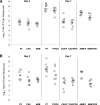Posaconazole activity against Candida glabrata after exposure to caspofungin or amphotericin B
- PMID: 18056279
- PMCID: PMC2224729
- DOI: 10.1128/AAC.01447-07
Posaconazole activity against Candida glabrata after exposure to caspofungin or amphotericin B
Abstract
We evaluated the effects of sequential therapy with caspofungin (CAS) or amphotericin B (AMB) followed by posaconazole (POS) against Candida glabrata. The susceptibilities to POS of yeast cells pre-exposed to CAS or AMB were identical to those of untreated cells as shown by standard Clinical and Laboratory Standards Institute broth dilution, cell viability, and disk diffusion methods. We then investigated the activity of sequential regimens in an experimental model of disseminated candidiasis. CAS given at 1 mg/kg/day for 2 days followed by POS at either 15 or 30 mg/kg/day significantly reduced the counts compared to the controls, but this treatment was not superior to the use of CAS alone. Also, sequential regimens with AMB given at 1 mg/kg/day for 2 days followed by POS (AMB/POS) were effective at reducing the fungal burden against the controls. In addition, AMB/POS with both doses of the triazole were significantly more effective than AMB alone. Overall, our data showed that there is no therapeutic advantage in using CAS followed by POS, whereas an induction therapy with AMB followed by a maintenance regimen with POS might be a suitable strategy in managing C. glabrata infections.
Figures


Similar articles
-
Posaconazole against Candida glabrata isolates with various susceptibilities to fluconazole.Antimicrob Agents Chemother. 2008 Jun;52(6):1929-33. doi: 10.1128/AAC.00130-08. Epub 2008 Apr 7. Antimicrob Agents Chemother. 2008. PMID: 18391037 Free PMC article.
-
Caspofungin in combination with amphotericin B against Candida glabrata.Antimicrob Agents Chemother. 2005 Jun;49(6):2546-9. doi: 10.1128/AAC.49.6.2546-2549.2005. Antimicrob Agents Chemother. 2005. PMID: 15917570 Free PMC article.
-
Caspofungin in combination with amphotericin B against Candida parapsilosis.Antimicrob Agents Chemother. 2007 Mar;51(3):941-5. doi: 10.1128/AAC.00880-06. Epub 2006 Dec 11. Antimicrob Agents Chemother. 2007. PMID: 17158939 Free PMC article.
-
Candida and candidaemia. Susceptibility and epidemiology.Dan Med J. 2013 Nov;60(11):B4698. Dan Med J. 2013. PMID: 24192246 Review.
-
Antifungal resistance: the clinical front.Oncology (Williston Park). 2004 Dec;18(14 Suppl 13):15-22. Oncology (Williston Park). 2004. PMID: 15682590 Review.
Cited by
-
Pharmacokinetic/pharmacodynamic profile of posaconazole.Clin Pharmacokinet. 2010 Jun;49(6):379-96. doi: 10.2165/11319340-000000000-00000. Clin Pharmacokinet. 2010. PMID: 20481649 Review.
-
Clinical pharmacodynamics and pharmacokinetics of the antifungal extended-spectrum triazole posaconazole: an overview.Br J Clin Pharmacol. 2010 Oct;70(4):471-80. doi: 10.1111/j.1365-2125.2010.03680.x. Br J Clin Pharmacol. 2010. PMID: 20840439 Free PMC article.
-
Design of a mimotope-peptide based double epitope vaccine against disseminated candidiasis.Vaccine. 2019 Apr 24;37(18):2430-2438. doi: 10.1016/j.vaccine.2019.03.061. Epub 2019 Mar 28. Vaccine. 2019. PMID: 30930005 Free PMC article.
-
Surgical pathology and the diagnosis of invasive visceral yeast infection: two case reports and literature review.World J Emerg Surg. 2013 Sep 26;8(1):38. doi: 10.1186/1749-7922-8-38. World J Emerg Surg. 2013. PMID: 24067049 Free PMC article.
-
In vitro susceptibilities of invasive isolates of Candida species: rapid increase in rates of fluconazole susceptible-dose dependent Candida glabrata isolates.Antimicrob Agents Chemother. 2008 Aug;52(8):2919-22. doi: 10.1128/AAC.00323-08. Epub 2008 May 5. Antimicrob Agents Chemother. 2008. PMID: 18458136 Free PMC article.
References
-
- Anstead, G. M., M. Martinez, and J. R. Graybill. 2006. Control of a Candida glabrata prosthetic endovascular infection with posaconazole. Med. Mycol. 44:273-277. - PubMed
-
- Cacciapuoti, A., D. Loebenberg, E. Corcoran, F. Menzel, E. L. Moss, C. Norris, M. Michalski, K. Raynor, J. Halpern, C. Mendrick, B. Arnold, B. Antonacci, R. Parmegiani, T. Yarosh-Tomaine, G. H. Miller, and R. S. Hare. 2000. In vitro and in vivo activities of SCH 56592 (posaconazole), a new triazole antifungal agent, against Aspergillus and Candida. Antimicrob. Agents Chemother. 44:2017-2022. - PMC - PubMed
-
- Clinical and Laboratory Standards Institute/National Committee for Clinical Laboratory Standards. 2004. Method for antifungal disk diffusion susceptibility testing of yeasts. Approved guideline. Document M44-A. National Committee for Clinical Laboratory Standards, Wayne, PA.
-
- Cornely, O. A., J. Maertens, D. J. Winston, J. Perfect, A. J. Ullmann, T. J. Walsh, D. Helfgott, J. Holowiecki, D. Stockelberg, Y. T. Goh, M. Petrini, C. Hardalo, R. Suresh, and D. Angulo-Gonzalez. 2007. Posaconazole versus fluconazole or itraconazole prophylaxis in patients with neutropenia. N. Engl. J. Med. 356:348-359. - PubMed
MeSH terms
Substances
LinkOut - more resources
Full Text Sources
Medical

